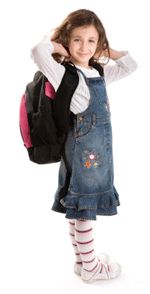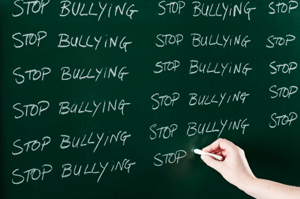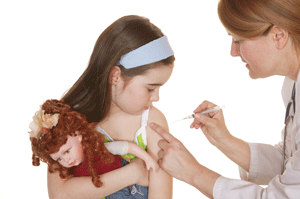 Backpack Hygiene
Backpack Hygiene
- Choose a backpack with wide, padded shoulder straps and a padded back.
- Pack light. Organize the backpack to use all of its compartments. Pack heavier items closest to the center of the back. The backpack should never weigh more than 10 to 20 percent of your child’s body weight.
- Always use both shoulder straps. Slinging a backpack over one shoulder can strain muscles.
- If your school allows, consider a rolling backpack. This type of backpack may be a good choice for students who must tote a heavy load. Remember that rolling backpacks still must be carried up stairs, and they may be difficult to roll on uneven surfaces and in heavy rains.
Developing Good Homework and Study Habits
- Create an environment that is conducive to doing homework. Youngsters need a permanent workspace in their bedroom or another part of the home that offers privacy.
- Schedule ample time for homework.
- Establish a household rule that the TV set stays off during homework time.
- Supervise computer and internet use.
- Be available to answer questions and offer assistance, but never do a child’s homework for her.
- Take steps to help alleviate eye fatigue, neck fatigue and brain fatigue while studying. It may be helpful to close the books for a few minutes, stretch, and take a break periodically when it will not be too disruptive.
- If your child is struggling with a particular subject, and you aren’t able to help her yourself, a tutor can be a good solution. Talk it over with your child’s teacher first.
- Establish a routine and schedule for homework (a specific time and place) and adhere to the schedule as closely as possible. Don’t allow your child to wait until the evening to get started.
- Monitor and give feedback without doing all the work together. You want your child to attempt as much as possible independently.
- You can assist your child in getting started on assignments (e.g., read the directions together, do the first items together, observe as your child does the next problem/item on his or her own). Then get up and leave.
- Praise and compliment your child when he or she puts forth good effort and completes tasks. In a supportive, noncritical manner it is appropriate and helpful to assist in pointing out and making some corrections of errors on the homework.
- Sometimes it’s helpful to offer mini rewards (star charts, stickers or other small incentives) to a child who is having a particularly difficult tome getting motivated to get their homework done.
Traveling To and From School
Car
- All passengers should wear a seat belt and/or an age- and size-appropriate car safety seat or booster seat.
- Your child is ready for a booster seat when she has reached the top weight or height allowed for her car seat, her shoulders are above the top harness slots, or her ears have reached the top of the seat.
- Your child should ride in a belt-positioning booster seat until the vehicle’s seat belt fits properly (usually when the child reaches about 4′ 9″ in height and is between 8 to 12 years of age). This means that the child is tall enough to sit against the vehicle seat back with her legs bent at the knees and feet hanging down with the shoulder belt lying across the middle of the chest and shoulder, not the neck or throat. The lap belt should be low and snug across the thighs, and not the stomach.
- All children younger than 13 years of age should ride in the rear seat of vehicles. If you must drive more children than can fit in the rear seat (when carpooling, for example), move the front-seat passenger’s seat as far back as possible and have the child ride in a booster seat if the seat belts do not fit properly without it.
- Remember that many crashes occur while novice teen drivers are going to and from school. You should require your teens to use seat belts and not allow your teen to drive friends during their probationary period, which is the first year of their license. Once that probationary period is over, limit the number of friend your teen can drive at one time and do not allow eating, drinking, cell phone conversations or texting while your teen is driving, to prevent driver distractions. Set a good example by also following these rules. Also, limiting nighttime driving is a good idea. Consider the use of a parent-teen driver agreement to facilitate the early driving learning process. For a sample parent-teen driver agreement, see www.healthychildren.org/teendriver
Bike
- Always wear a bicycle helmet, no matter how short or long the ride.
- Make sure the helmet is properly fitted, not loosely worn.
- Ride on the right, in the same direction as auto traffic.
- Use appropriate hand signals.
- Respect traffic lights and stop signs.
- Wear bright colored clothing to increase visibility.
Walking to School
- Make sure your child’s walk to a school is a safe route with well-trained adult crossing guards at every intersection.
- Be realistic about your child’s pedestrian skills. Because small children are impulsive and less cautious around traffic, carefully consider whether or not your child is ready to walk to school without adult supervision.
- If your children are young or are walking to a new school, walk with them the first week or until you are sure they know the route and can do it safely.
- Bright colored clothing will make your child more visible to drivers.
- In neighborhoods with higher levels of traffic, consider starting a “walking school bus,” in which an adult accompanies a group of neighborhood children walking to school.
School Bus
- If your child’s school bus has lap/shoulder seat belts, make sure your child uses one at all times when in the bus. If your child’s school bus does not have lap/shoulder belts, encourage the school to buy or lease buses with lap/shoulder belts.
- Wait for the bus to stop before approaching it from the curb.
- Do not move around while on the bus.
- Check to see that no other traffic is coming before crossing the street.
- Make sure to always remain in clear view of the bus driver.
- Children should always board and exit the bus at locations that provide safe access to the bus or to the school building.
Eating During the School Day
- Most schools regularly send schedules of cafeteria menus home. With this advance information, you can plan on packing lunch on the days when the main course is one your child prefers NOT to eat.
- Planning ahead of time is key.
- Avoid packing juices, chips and cookies. Try to replace those items with fruit, vegetable (celery sticks, carrots, cucumbers), whole-wheat crackers, or plain water.
- Carry a healthy snack when you pick your child up from school as they are often “starving” right after school. This will help you avoid the drive-trough window or the ice cream truck.
- Try to get your child’s school to stock healthy choices such as fresh fruit, low-fat dairy products, and water in the vending machines. Each 12-ounce soft drink contains approximately 10 teaspoons of sugar and 150 calories. Drinking just one can of soda a day increases a child’s risk of obesity by 60%. Restrict your child’s soft drink consumption.
 Bullying
Bullying
Bullying is when one child picks on another child repeatedly. Bullying can be physical, verbal, or social. It can happen at school, on the playground, on the school bus, in the neighborhood, or over theinternet.
When Your Child Is Bullied
- Help your child learn how to respond by teaching your child how to:
- Look the bully in the eye.
- Stand tall and stay calm in a difficult situation.
- Walk away.
- Teach your child how to say in a firm voice.
- “I don’t like what you are doing.”
- “Please do NOT talk to me like that.”
- “Why would you say that?”
- Teach your child when and how to ask for help.
- Encourage your child to make friends with other children.
- Support activities that interest your child.
- Alert school officials to the problems and work with them on solutions.
- Make sure an adult who knows about the bullying can watch out for your child’s safety and well-being when you cannot be there.
When Your Child Is the Bully
- Be sure your child knows that bullying is never OK.
- Set firm and consistent limits on your child’s aggressive behavior.
- Be a positive role mode. Show children they can get what they want without teasing, threatening or hurting someone.
- Use effective, non-physical discipline, such as loss of privileges.
- Develop practical solutions with the school principal, teachers, counselors, and parents of the children your child has bullied.
When Your Child Is a Bystander
- Tell your child not to cheer on or even quietly watch bullying.
- Encourage your child to tell a trusted adult about the bullying.
- Help your child support other children who may be bullied. Encourage your child to include these children in activities.
- Encourage your child to join with others in telling bullies to stop.
 Get The Flu Vaccine
Get The Flu Vaccine
The best time to get the flu vaccine is the early fall or as soon as it is available in your community. If your child does not get the flu vaccine right away, it is still important to get it anytime. The flu virus infects people in the fall, winter, and well into the spring each year. Your child can still be protected if she gets a flu vaccine as late as March, April, or May. Please contact our office to schedule your child’s flu vaccine if you have not already done so. You can also schedule an appointment online.
There are 2 types of flu vaccine.
Trivalent inactivated influenza vaccine (TIV) is given as a shot.
There are 2 kinds of shots. The intramuscular (into the muscle) shot is licensed and recommended for children 6 months and older and adults, including people with and without chronic medical conditions. The new intradermal (into the skin) shot has been licensed for the 2011–2012 season to use in people 18 through 64 years of age.
Vaccination is especially important for people at higher risk of getting severely ill from the flu and their close contacts, the close contacts of healthy children younger than 5 years, all health care personnel, and all pregnant (or postpartum) women.
Live-attenuated influenza vaccine (LAIV) is sprayed into the nose.
LAIV is recommended for healthy children 2 years and older.
Both types of flu vaccine are very safe and work well to protect your child from the flu. Check with your doctor about which is best for your child and family.
Are there side effects of the flu vaccine?
There are very few side effects of the flu vaccine. The area where the TIV flu shot is given may be sore for a day or two. Fever may occur within 24 hours after in about 10% to 35% of children younger than 2 years, within 24-48 hours of receiving the vaccine, but rarely in older children and adults.
Because LAIV is sprayed into the nose, your child might get a stuffy, runny nose within the first few days. LAIV may produce mild symptoms, including runny nose, headache, wheezing, vomiting, muscle aches, and fever.
You or your children will not get the flu from the vaccine. It takes 2 weeks for the vaccine to start working, so people can catch the flu before they are protected.
Keep flu germs from spreading
The flu virus spreads easily through the air with coughing and sneezing, and through touching things like doorknobs or toys and then touching your eyes, nose, or mouth. Here are some tips that will help protect your family from getting sick.
- Everyone should wash their hands often. You can use soap and warm water for at least 20 seconds. That is about as long as singing the “Happy Birthday” song 2 times. An alcohol-based hand cleanser or sanitizer works well too. Put enough on your hands to make them all wet, then rub them together until dry.
- Teach your child to cover his mouth and nose when coughing or sneezing. Show your child how to cough into the elbow or upper sleeve (not a hand) or use a tissue.
- Throw all tissues used for runny noses and sneezes in the trash right away.
- Wash dishes and utensils in hot, soapy water or the dishwasher.
- Don’t let children share pacifiers, cups, spoons, forks, washcloths, or towels without washing. Never share toothbrushes.
- Teach your child to try not to touch her eyes, nose, or mouth.
- Wash doorknobs, toilet handles, countertops, and even toys. Use a disinfectant wipe or a cloth with soap and hot water. (A disinfectant is a cleaner that kills germs.)
Signs of the flu
All flu viruses cause a respiratory illness that can last a week or more. Flu symptoms include
- A sudden fever (usually above 101°F or 38.3°C)
- Chills and body shakes
- Headache, body aches, and being a lot more tired than usual
- Sore throat
- Dry, hacking cough
- Stuffy, runny nose
Some children may throw up (vomit) and have loose stools (diarrhea). Talk with your child’s doctor if your child has ear pain, difficulty with breathing, a cough that lasts greather than 10-14 days, or a fever that is concerning you. There can be serious complications, even death, from the flu, but serious complications are uncommon.
Sport Injuries
- Most frequent sports injuries are sprains (injuries to ligaments) and strains (injuries to muscles), caused when an abnormal stress is placed on tendons, joints, bones and muscle.
- Ankle sprains are the most common injury, comprising 15% to 20% of all sports injuries.
- Once someone has an injury, if they continues to play sports before the injury has healed, the chances of having another injury are greater.
- Completely fixing the first injury is very important, since returning to play before an injury has healed is a common risk factor for future injuries.
- The second most common injury in athletes is concussion, comprising at least 10% of sports injuries. If your child is involved in any contact sports (football, basketball, soccer…) it extremely important that parents and coaches educate themselves on concussion: http://www.cdc.gov/concussion/
To reduce the risk of injury:
- Time off. Plan to have at least 1 day off per week from a particular sport to allow the body to recover.
- Wear the right gear. Players should wear appropriate and properly fitting protective equipment such as pads (neck, shoulder, elbow, chest, knee, shin), helmets, mouthpieces, face guards, protective cups, and/or eyewear. Young athletes should not assume that protective gear will protect them when performing more dangerous or risky activities.
- Strengthen muscles. Conditioning exercises before games and during practice strengthens muscles used in play.
- Increase flexibility. Stretching exercises before and after games or practice can increase flexibility.
- Use the proper technique. This should be reinforced during the playing season.
- Take breaks. Rest periods during practice and games can reduce injuries and prevent heat illness.
- Play safe. Strict rules against headfirst sliding (baseball and softball), spearing (football), and body checking (ice hockey) should be enforced.
- Stop the activity if there is pain.
- Avoid heat injury by drinking plenty of fluids before, during and after exercise or play; decrease or stop practices or competitions during high heat/humidity periods; wear light clothing.

 Backpack Hygiene
Backpack Hygiene Bullying
Bullying Get The Flu Vaccine
Get The Flu Vaccine